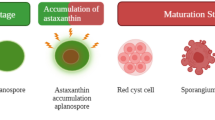Abstract
In our laboratory, one Monascus anka mutant able to produce high yield of yellow pigments screened by physical and chemical combination mutagenesis was obtained. This study evaluated peptone, NH4NO3 and KH2PO4 as the most significant variables for Monascus yellow pigment production by this M. anka mutant MYM in submerged fermentation. Response surface methodology (RSM) optimized these nutrient parameters for maximum yellow pigment production (87.24 OD units), which resulted at 10.3 g/L peptone, 11.9 g/L NH4NO3 and 4.7 g/L KH2PO4 in the medium. According to the fitting equation, through five replication experiments under the optimized conditions, the average yellow pigment production obtained was 88.14 OD units for flask cultivation and 92.45 OD units for 5 L fermenter cultivation. Meanwhile, the citrinin could not be detected by HPLC method.




Similar content being viewed by others
References
Simone Pereira Alves, Daniel Mares Brμm, Édira Castello Branco de Andrade, Annibal Duarte Pereira Netto (2008) Food Chem 107(1):489–496
Sato S, Kitamura H, Chino M, Takei Y, Hiruma M, Nomura M (2007) Food Chem Toxicol 45(8):1537–1544
Chen L, Ding L, Zhang H, Li J, Wang Y, Wang X, Qu C, Zhang H (2006) Carthami nalytica Chimica Acta 58(1):75–82
Takaichi S, Maoka T, Akimoto N, Sorokin DY, Banciue H, Kuenen JG (2004) Tetrahedron Lett 45:8303–8305
Eisenbarth S, Steffan B (2000) Tetrahedron 56:363–365
Shier WT, Lao Y, Steele TW, Abbas HK (2005) Bioorg Chem 33:426–438
Misono Y, Ito A, Matsumoto J, Sakamoto S, Yamaguchid K, Ishibashi M (2003) Tetrahedron Lett 44:4479–4481
Blanc PJ, Loret MO, Santerre AL, Pareilleux A, Promeı D, Promeı JC, Laussac JP, Goma G (1994) J Food Sci 9:862–865
Ma J, Li Y, Ye Q, Li J, Hua Y, Ju D, Zhang D, Cooper R, Chang M (2000) J Agr Food Chem 48:5220–5225
Wild D, Toth G, Hμmpf HU (2002) J Agr Food Chem 50:3999–4002
Juzlova P, Martinkova L, K-ren V (1996) J Ind Microbiol 16:163–170
Sato K, Goda Y, Sakamoto SS, Shibata H, Maitani T, Yamada T (1997) Chem Pharm Bull 45:227–229
Jongrungruangchok S, Kittakoop P, Yongsmith B, Bavovada R, Teng SS, Feldheim W (2000) J Ind Microbiol Biotechnol 25:141–146
Kurono M, Nakanish K, Shindo K, Tada M (1963) J Chem Pham Bull 11:359–362
Endo A, Komagata D, Shimada H, Monakolin M (1986) J Antibiot 39:1670–1673
Hossain CF, Okuyama E, Yamazaki M (1996) Pharm Bull 44:1535–1539
Su YC, Wang JJ, Lin TT (2003) J Ind Microbiol Biotechnol 30:41–46
Blanc PJ, Loret MO, Goma G (1995) Biotechnol Lett 17:291–294
Ciegler A (1977) Appl Environ Microbiol 33:1004–1006
Wu MT (1974) Appl Microbiol 27:427–428
Kim HJ, Kim HJ, Oh HJ, Shin CS (2002) Process Biochem 38:649–655
Hamdi M, Blanc PJ, Goma G (1996) Process Biochem 31:543–547
Hajjaj H, Blanc PJ, Groussac E, Uribelarrea JL, Goma G, Loubiere P (2000) Enzyme Microb Technol 27:619–625
Pastrana L, Blane PJ, Santerre AL, Loret MO, Goma G (1995) Process Biochem 30:333–341
Tanasupawat S, Lartpornmatulee N, Thebtaranonth Y (2004) Phytochem 65:2569–2575
Yongsmith B, Krairak S, Bavavoda R (1994) J Ferment Bioeng 78:223–228
Buchanan RL, Philips JG (1990) J Food Protect 53:370–376
Haltrich D, Press M, Steiner W (1993) Enzyme Microb Technol 15:854–860
Prapulla SG, Jacob S, Chand N, Rajalakshmi D, Karanth NG (1992) Biotechnol Bioeng 40:965–969
Zertuche L, Zall RR (1985) Biotechnol Bioeng 27:547–554
Yongsmith B, Kitprechavanich V, Chitradon L, Chaisrisook C, Budda N (2000) J Mol Catal B Enzym 10:263–272
Plackett RL, Burman JP (1946) Boometrika 37:305–325
Box GEP, Wilson KB (1951) J Roy Statistical Soc (Ser. B) 13:1–45
Yongsmith B, Tabloka W, Yongmanitchai W, Bavavoda R (1993) World J Microbiol Biotechnol 9:85–90
Martinkova L, Patakova-Juzlova P, Kren V, Kucerova Z, Havlicek V, Olsovsky P, Hovorka O, Rihova B, Vesely D, Vesela D, Ulrichova J, Prikrylova V (1999) Food Addit Contam 16:15–24
Ganrong Xu, Yun Chen, Huiling Yu (2003) Archiv fur Lebensmittelhygiene 4:82–84
Acknowledgments
One of authors (Bo Zhou) thank Ph.D. Yuan for editing this manuscript.
Author information
Authors and Affiliations
Corresponding author
Rights and permissions
About this article
Cite this article
Zhou, B., Wang, J., Pu, Y. et al. Optimization of culture medium for yellow pigments production with Monascus anka mutant using response surface methodology. Eur Food Res Technol 228, 895–901 (2009). https://doi.org/10.1007/s00217-008-1002-z
Received:
Revised:
Accepted:
Published:
Issue Date:
DOI: https://doi.org/10.1007/s00217-008-1002-z




